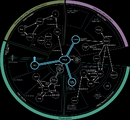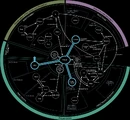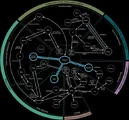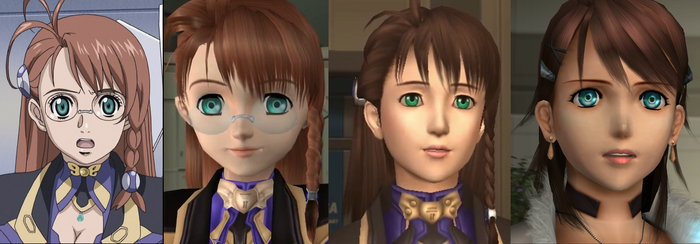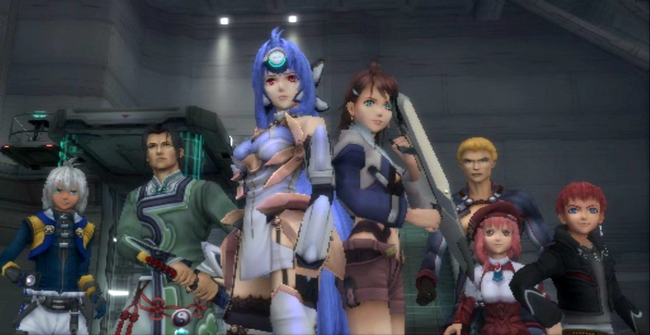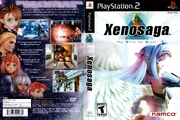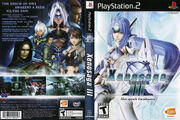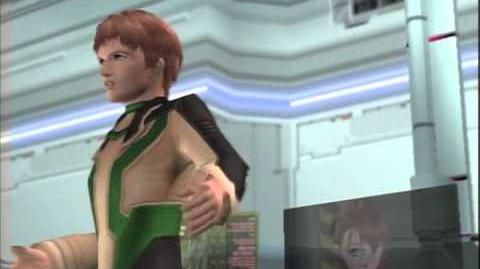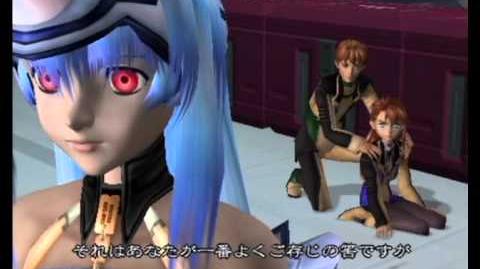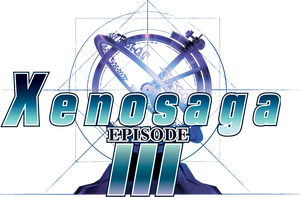
The logo of Xenosaga Episode III.
Xenosaga is primarily a series of futuristic RPG video games developed by Monolith Soft and published by Namco. Its main story is in the form of a trilogy of PlayStation 2 video games. Several side stories and spin-offs were also developed, as well an anime adaptation.
Xenosaga was a very ambitious project, intended to be about 6 episodes long, but due to budget and time constraints and other factors, 3 episodes were released. Episode III was forced to cram and condense the rest of the story into a single game.
Xenosaga is an epic-sized space opera that opens in the outer reaches of the galaxy thousands of years in the future in the year 6000-7277, in the 61st century to 73th century. Humanity has colonized 500,000 planets in outerspace, and hasn't lived on Earth in over 4000 years. The story follows several space-dwelling citizens as they aim to unlock the secrets of the universe. Humanity is on the verge of extinction due to a mysterious race of hostile aliens known as Gnosis.
Themes
On the surface, Xenosaga is known for its story character drama elements, conspiracy plot, mech robot battles, spaceships, swimsuits, anime presentation, technobabble, as well as its inconsistent voice acting as many characters feature different voice actors.
On a deeper level, however, Xenosaga contains deep religious, spiritual, alchemical and philosophical overtones (primarily Christianity). Xenosaga is a futuristic sequel to the Bible. Xenosaga is a commentary on how Christians are actually worshiping a perverted warped form of Christianity which resembles Satanism more than Christianity and Jesus' actual teachings and message.
It has visions and commentary on:
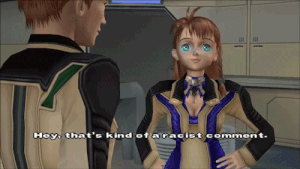
Yeah, Allen, quit being such a racist!
- Aesthetics
- Art
- Brainwashing and mind control
- Free will
- Good vs evil
- Language
- Life and existence
- Mental illness
- Metaphysics
- Morality
- Philosophy
- Racism
- Salvation
- Science and futurology
- The ascension and evolution of consciousness
- Trans-humanism
- Truth and lies
- Value
- War
All three episodes of the main Xenosaga trilogy are named after the books of Friedrich Nietzsche. Several Nietzschean concepts and references appear throughout the series.
Xenogears connections
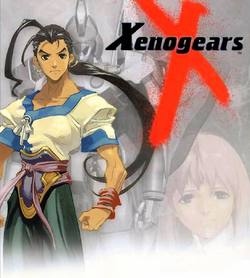
Xenogears.
The Xenosaga series serves as a spiritual successor to the game Xenogears, which was released in 1998 for the PlayStation by Squaresoft (now Square Enix). Outside of allusions and homages, there is no relationship between the two storylines, although it is was once commonly thought that Xenogears would somehow fit into the Xenosaga storyline. The creator of both Xenogears and Xenosaga is Tetsuya Takahashi, who left Squaresoft in 1999 along with Hirohide Sugiura. Using funds from Namco, they restarted Monolith Soft and the Xenosaga project.
While the timeline of Xenosaga does not correspond completely to that set out in Xenogears, the two are largely synchronous. T.C. 4767 is the year the events of the game take place, according to the Xenogears Perfect Works Book, but in that same year the Eldridge is supposed to have been launched and no mention of that is made in Episode I. However, Xenosaga does use several elements, themes, and plotlines from Xenogears.
Story
Plot summary
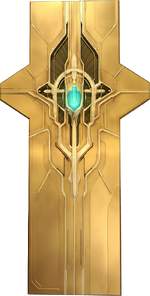
The Zohar: a central artifact in the Xenosaga series.
In Lake Turkana, Kenya, during an archaeological excavation, T. Masuda discovers the Zohar, a yellow artifact with mystical properties, in 20xx CE.
In the year T.C. 4767, which is 6000-7277 A.D, mankind exists on distant planets and artificial colonies. Humanity has abandoned Earth for thousands of years; Earth is seemingly gone and the path to it is unknown; it has been erased from starmaps and renamed "Lost Jerusalem". The capital of all known space is Fifth Jerusalem, where the Galaxy Federation supposedly keeps watch over mankind and colonized 500,000 planets in the galaxy.
For the past fourteen years, mysterious alien enemies known as the Gnosis has attacked man's colonies seemingly indiscriminately. Gnosis have been killing humans relentlessly, pushing humanity on the verge of extinction. It is largely believed that the Gnosis were brought into the universe by a scientist named Joachim Mizrahi during the Miltian Conflict of T.C. 4753, but there is more to that story than the public really knows.

U-DO in Episode II.
Ever since the Miltian Conflict and the resulting disappearance of Old Miltia, the Zohar has become a topic of interest. Several factions — chiefly the underground Ormus cult and the aforementioned Galaxy Federation — wish to harness its power. Both groups believe that the Zohar's significance is threefold; is a power source, the cause of the Gnosis crisis, and the virtual prison of U-DO, a formidable wave existence. Thus, the two factions believe that the Zohar could be the key to the Gnosis destruction and a pathway to unlimited power.
Tests on the Zohar and its power have been conducted by Joachim Mizrahi, the Galaxy Federation, and a mysterious scientist known as Sellers, whose affiliation is with Ormus and the Hyams Group. The results of these tests was the development of several Zohar Emulators, or copies of the original Zohar, which vanished when Miltia was sealed off. However, the original Zohar's power still eclipses the energy output of any known Emulator, despite the fact that one of the Emulators caused the disappearance of the planet Ariadne.
As a result of these discoveries and experiments, the Ormus society and the Galaxy Federation have grown obsessed with finding the original artifact that was sealed away on Miltia at the end of the Miltian Conflict. However, the key to unlocking Miltia and the Original Zohar is contained within the Y-Data, which is in the hands of a Realian called MOMO Mizrahi. In order to retrieve the Y-Data, Ormus must hatch a plot against the Galaxy Federation and its allies by using a series of dummy organizations and insiders, including the U-TIC Organization and an enigmatic figure known as Albedo Piazzolla.

Beginning of a Saga
Vector Industries develops the KOS-MOS Project.
Meanwhile, Vector Industries, the largest corporation in existence and the primary arms manufacturer for the Galaxy Federation, is currently researching new ways to use nanotechnology to build an unstoppable battle android, code-named KOS-MOS. This is quite controversial, since androids have been replaced for many, many years by artificial life-forms known as Realians, which have proven far more effective in combat. However, Vector Industries and their head of R&D, Shion Uzuki, have other ideas. Shion, a simple researcher traveling on the starship Woglinde, becomes involved in a conspiracy not only to control the mysterious Gnosis and Original Zohar, but to reshape the destiny of all mankind.
Main characters
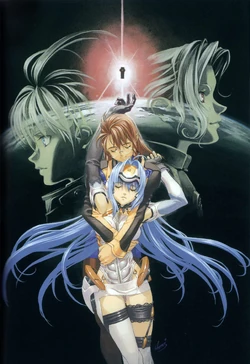
Shion's love for KOS-MOS is a core theme of Xenosaga.
Xenosaga features a cast that is slowly introduced as the series develops. Almost each cast member (sans KOS-MOS) is dealing with their own unique sort of pain and trauma, especially Shion, Jr. and Ziggy. Allen and Jin also suffer from slight emotional pain, both of them suffer from unrequited love for Shion. The following is a brief description of the main characters featured in the series.
- Shion Uzuki — The protagonist of the series. She is the chief engineer of Vector Industries' First R&D Division. Shion is a young woman who is the lead designer in the KOS-MOS project. She also specializes in Realian technology. However, as the plot develops and corruption is revealed, Shion distances herself from Vector. Shion is ignorant to the fact that her role in the story is greater than it appears.
- KOS-MOS — KOS-MOS is a female battle android developed by Vector Industries (primarily Shion and Kevin Winnicot). Although her development was delayed by an incident two years prior to Episode I, she becomes fully functional during the Woglinde disaster. KOS-MOS has a strong loyalty to Shion that is only overruled by unknown commands from Vector Industries.
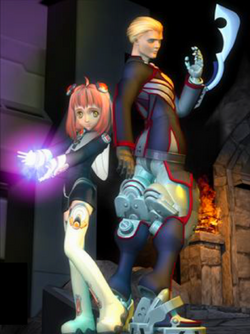
MOMO and Ziggy in Episode I.
- Ziggy — A humanoid cyborg who wishes to be brainwashed because of traumatic experiences as a human. Ziggurat 8 ("Ziggy") befriends MOMO while rescuing her from the U-TIC asteroid "Pleroma" during Episode I. Ziggy's past rises again in several instances, primarily in Episode II.
- MOMO Mizrahi — A female 100-Series Observational Realian developed by Joachim Mizrahi and modeled after his daughter Sakura Mizrahi, MOMO is captured by the U-TIC Organization because she carries valuable information: the Y-Data. MOMO soon befriends Ziggurat 8 when he rescues her from Pleroma. As the story continues, MOMO also develops a close relationship with Jr. and Ziggy.
- chaos — An enigmatic figure who appears to be a white-haired teenager. A member of the Elsa crew, chaos' origins are unknown. However, he does possess the power to destroy Gnosis with the touch of his hand.
- Jr. — A U.R.T.V. unit who played an integral role in the Miltian Conflict, Jr. is a man trapped in a child's body due to his gene modification. Currently, Jr. is a leader of the Kukai Foundation, which is run by his fellow U.R.T.V., Gaignun Kukai. Throughout Episode I and Episode II, Jr. develops a relationship with MOMO.
- Jin Uzuki — Shion Uzuki's older brother, Jin Uzuki runs a bookstore on Second Miltia. However, he was once a sword-wielding Federation commander who attempted to unlock the truth behind the Miltian Conflict. In Episode II, he joins the quest to confirm what he learned about the Conflict.
- Allen Ridgeley — Shion's assistant and friend, Allen is the second in command of the KOS-MOS project. Although two years older than Shion, he is relatively new to Vector Industries and is her junior in the organization. Allen often acts shy around Shion because he is in love with her, although she is rather oblivious to this fact.
Allusions and influences
Like Xenogears, Xenosaga contains religious and historical allusions, which often involve names and terms. For example, "KOS-MOS" is derived from the Greek 'kosmos', originally meaning "ornament or decoration", eventually coming to mean "universe, order, and harmony". Another example is chaos, who is also identified as "Yeshua". Furthermore, "Abel" and "Abel's Ark" are references to a biblical figure of the same name.
Xenosaga's storyline has several influences, including Gnostic plot devices. Intertwined with the symbolism of the series are themes of Nietzsche, Jungian psychology, and the biblical Book of Revelation. Buried beneath the mythological and psychological references are the questions the series asks, which often deal with the meaning of life and the truth behind figures and artifacts.
Xenosaga's vision of the future
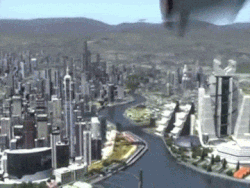
A futuristic city filled with flying cars.

Fifth Jerusalem's park.
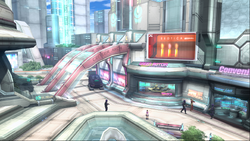
Miltia's Urban A District.
- Humanity does not exist on Earth, and has colonized 500,000 planets in outerspace. Earth is re-named Lost Jerusalem and the path to it is no longer known. Interplanetary travel is available through abundant spaceships.
- Humanity has almost mastered technology and science, and is much more advanced.
- Ether is like magic, but rooted in science. When used, characters say "Ether Drive!" and "Open Ether Circuit!" It can do many things, like allow people to heal themselves, run and move faster, shoot fire beams, increase physical strength and endurance, etc. However, Episode II requires licenses to be obtained, and Ether may possibly be required to be learned first (for example, before you go around shooting fireballs, you must learn how to first).
- The U.M.N. is a mysterious informational network that spans the entire universe and the 500,000 colonized planets. It is essentially the Internet. Anyone can connect to the U.M.N. via public terminals or portable connection devices. Its non-locality is a large factor in its use in space warps and FTL (faster than light) communications. The U.M.N. uses the Collective Unconscious as a network infrastructure.
- Because no one has lived on Earth for thousands of years, nationality is attributed by planets instead. There is no such thing as being "Mexican", "African", "Japanese", "German", etc, but rather "Miltian", "Gedalyan", "Brezzan", etc. All planets work together in unison for the best future for humanity. The concept of separate "races" and "ethnicities" are also ignored.
- The universe uses a universal digital virtual monetary currency called Credit so there is no need to convert between planets. It is also synced to the U.M.N. (the Internet). Its symbol is G, and it's rounded to the nearest whole number so there is no such thing as cents or 2.50 or 2.75, it's either 2G or 3G. Ice cream may be anywhere from 80G to 1000G. There is also no evidence of physical money (coins and paper bills) existing, eliminating humans robbing, stealing, and murdering other humans for paper bills. Payments and purchases are recorded online, so transactions can be refuted, disputed, refunded in cases of emergencies, defected products, fraud or scams. For a comparison, it's like PayPal.com, but synced to the entire universe and every shop in it.
- Everyone speaks the same unified language (English), although some may have specific planetary slang or a planetary accent (like Mary Godwin).
- There is a strong interest in Lost Jerusalem (Earth) culture and antiques such as books.
- Christianity, or possibly a sect of Christianity, has become Ormus. There is no evidence or mention of any non-Christian religions existing.
- It seems no signs of other intelligent life have been found such as aliens (excluding the Gnosis, however, it's eventually revealed that Gnosis are human souls). It's primarily just humans, genetically modified humans, and robots.
- Multiple new species have emerged, including:
- androids — pure robots with AIs.
- cyborgs — humans combined with robotic parts. Cyborgs are considered obsolete technology.
- Designer Children - genetically modified humans, usually for looks, intelligence, health and disease-free. Subgroups include:
- Realians — artificial mix between human and robot. Realians can also be categorized as androids.
- Überhuman — humans modified early in life. Offspring of Überhumans are called Übermutants.
- U.R.T.V. — hundreds of genetically modified partial-humans meant to counter U-DO. Four unique Variants have special abilities.
- Designer Children - genetically modified humans, usually for looks, intelligence, health and disease-free. Subgroups include:
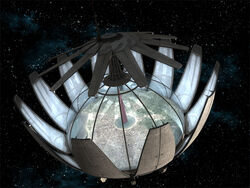
The Kukai Foundation.
- The Kukai Foundation is a free orbiting space colony.
- The world is post-scarcity. Poverty, homelessness and starvation apparently do not exist because food, housing, knowledge and health care are basic human rights guaranteed to everyone just for being human - no questions asked. There is not a single known homeless human in the entire universe.
- However, war and racism still exists to a certain degree, usually by humans against Realians (especially after the Miltian Conflict) and Überhumans. Allen Ridgeley makes a slightly racist comment against Übermutants.[1] Wars include the Zoar Incident and Miltian Conflict.
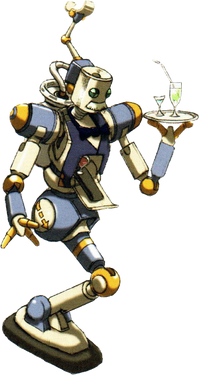
ADONIS, the Elsa's robot bartender.
- Robots and automated jobs and work is normal (for example, the robot in the bar on the Elsa). The concept of humans devoting a huge portion of their lives, living paycheck-by-paycheck in order to pay man-made bills and survive is considered extremely archaic. Phrases like "earning a living" and "what do you do for a living?" aren't said because it is a slavethink term insinuating that if humans don't "do" and "work", they aren't allowed to "live" and should die. It is likely that some sort of universal basic income system is in place, and it is perfectly acceptable to be unemployed. Jobs still exist, but the amount of work required has been reduced due to automation and technology.
- Capital punishment (punishment by death) is considered cruel, archaic, barbaric, inhumane and a remnant of the stone age. It has been abandoned by the Galaxy Federation for thousands of years in favor of "personality reconditioning". There is also no evidence of prisons existing. All criminals are forced to undergo personality reconditioning at facilities with no exceptions. Every crime is given a certain level (e.g. Level 3 personality reconditioning, level 5 personality reconditioning) according to the type and severity of the crime (the worse the crime, the higher the level required). After a criminal has successfully completed their re-education programs, they are allowed to return to society.
- In Episode I, Margulis comments, "The people of this world have cast away their will to create, drowning themselves instead in an endless cycle of consumption. What you see now is the deceitful light cast by their stagnant eyes." In Episode II, Sergius XVII says, "Thanks to the U.M.N. and the Federation. They've managed to reduce the people to a mass of spineless weaklings." Both of these comments imply that much of humanity lacks and is incapable of independent free thought, and has a weak-willed and consumerist mindset. (sheeple, mind control, brainwashing, etc)
- Mental health, as well as mental/physical disabilities, are taken extremely seriously. Jin comments that aside from mental illness, almost all diseases can be cured with medicine and nanotechnology, and that doctors mainly serve as conversationalists for the elderly. However, Mrs. Cherenkov comments that nanotechology isn't perfect and still can't correct mutation in genomes and fix abnormal DNA.
- Sellers uses a hoverchair instead of a wheelchair.
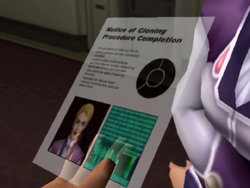
A human cloning permit.
- Human cloning is available as a privilege to a select few who are physically and mentally stable, have positive contributions to the Galaxy Federation, and have filled out a lengthy application process. Mrs. Cherenkov did this, but she needed Cherenkov's support.
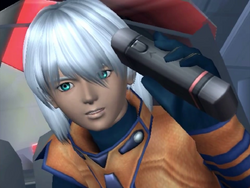
chaos holding a mini futuristic fire extinguisher.
- In Episode II, chaos holds a futuristic mini fire extinguisher. It is lightweight, child-friendly, and can easily fit in one hand with a single, simple button. It is possibly refillable too.
- Juli Mizrahi mentions that the "the average lifespan of a living brain that hasn't undergone extension is 130 years".[2] Whether or not Juli is referring to humans or cyborgs is unknown. If Juli is referring to humans, then this means a human who hasn't undergone life extension lives to 130 years old. With life extension, it could be anywhere from 131-500 years old.

Ambush in the City
Car chase on Second Miltia.
- Electric-powered hover cars have self-driving technology that can switch between manual and auto.[3]
- Books, print and physical paper is mainly considered archaic and antique. Books have been converted to digital formats and are distributed digitally via the U.M.N.
- Hovercars are a form of transportation.[4]
- A virtual reality exists called Encephalon. It is a massive, virtual reality world normally accessed through the assistance of special red goggles. It is similar to lucid dreaming. Furthermore, the Encephalon can recreate locations in absolute detail.
Questionable visions of the future
The Xenosaga series was released 2003-2006 and is set between 6000-7277. For a video game set at least 4000 years in the future, many aspects seen in Xenosaga are questionable:
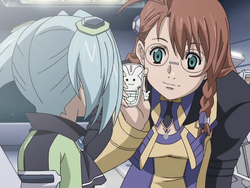
Shion's Bunnie phone.
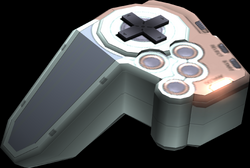
Connection Gear.
- Shion's Bunnie phone is very dated and Connection Gears seem bulky.
- Holograms seem blurry at times and are interlaced, along with low-quality audio/video.
- In Episode I, Jr. says, "Paper and stone tablets last longer than optical data, you know.", as if digital futuristic flash drives, hard drives and cloud storage are somehow unreliable.
- Shion, Allen and KOS-MOS are seen handwashing piles of dishes on the Elsa.
- Matthews and Tony are seen smoking on the Elsa, and a S.O.C.E. member, despite all the currently known negative health effects of smoking such as lung cancer, chronic disease, heart attacks, etc. It is possible they are smoking a non-toxic variant.
- Shion makes a reference to H. G. Wells's aliens and Albedo references Paul McCartney of The Beatles. Apparently, not all Lost Jerusalem culture is lost.
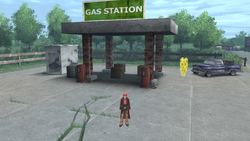
Gas Station.

Virginian Bright.
- Sakura's subconscious domain inexplicably has a gas station and a Virginia billboard.
- One possible explanation is that Sakura's subconscious domain is connected to the U.M.N., or the collective unconscious, and thus the memories of the deceased from the era of Lost Jerusalem/Earth.
- The Professor looks aged for someone in his 60s, which is questionable human life expectancy. It's also possible he rejected the aforementioned "life extension".
- Shion and Allen are seen eating prosciutto in Episode III, which is ham.[5] It is questionable what the ethics of eating meat is in the future, and if there is slaughter-free and cruelty-free vegetarian ham alternatives and artificial substitutes.
Primary PlayStation 2 trilogy
Xenosaga Episode I: Der Wille zur Macht
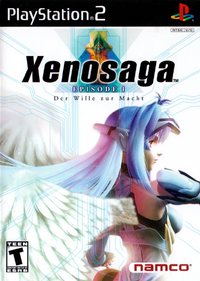
Episode I.
- Main article: Xenosaga Episode I: Der Wille zur Macht
Xenosaga Episode I: Der Wille zur Macht is the first title in the series. Der Wille zur Macht, can be translated as "The Will To Power", but "The Will to Make" is a better translation and is a reference to Nietzsche's thus named concept of an assumed rudimentary a-teleological force that elicits all activity stinted to existence itself.
Episode I serves as an exposition to the storyline; it introduces or mentions most of the main protagonists and antagonists, establishes a plot involving the Gnosis and the recovery of the Zohar Emulators, and provides foreshadowing to important past or future events. Several plot points such as the significance of the Miltian Conflict, the manipulators behind the U-TIC Organization, and the backstories and motivations of many characters are left unanswered for the player to question prior to playing Episode II.
Episode I generally received high marks, although critics were mixed about a variety of issues (see section).
The game's battle system introduces new concepts not common among popular RPG titles, and the majority of the soundtrack is performed by the London Philharmonic Orchestra.
Xenosaga Episode II: Jenseits von Gut und Böse
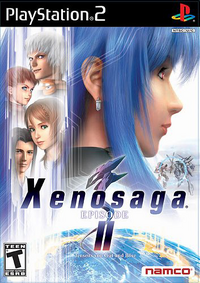
Episode II.
- Main article: Xenosaga Episode II: Jenseits von Gut und Böse
Xenosaga Episode II: Jenseits von Gut und Böse is the second installment in the series. Jenseits von Gut und Böse can be loosely translated as "Beyond Good and Evil", but it literally means "The other side of Good and Evil" and is taken from a philosophical book by Friedrich Nietzsche of the same name.
Episode II continues the storyline started in Episode I. The backstories and significance of Albedo Piazzolla, Nigredo/Gaignun, and Jr. are developed. Multiple secret organizations are uncovered, including Ormus and Hyams. The Gnosis take a back seat for Episode II; instead, the main plot focuses the search for the Zohar, which culminates in a crisis at the location of Old Miltia. The cast from Episode I plays an important role in the events that transpire on Old Miltia. Although there are several loose ends and characters unaccounted for in Episode II, it concludes without a sudden cliffhanger. This is underscored by the fact that Episode III will take place a full year later.
Episode II changes some of Episode I's elements, including different graphics, a modified battle system, new music composers, and shorter cutscenes. These changes led to mixed results (see section). After the release of Episode II, several Monolith Soft employees were removed from the project.
Xenosaga Episode III: Also sprach Zarathustra
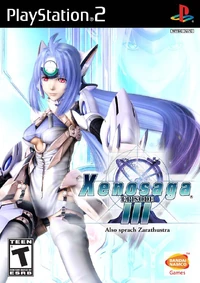
Episode III.
- Main article: Xenosaga Episode III: Also sprach Zarathustra
Xenosaga Episode III: Also sprach Zarathustra is the third and final game of the primary series. Also sprach Zarathustra, literally "Thus Spoke Zarathustra", is also the title to Nietzsche's most famous novel, which introduced the Übermensch and popularized the phrase "God is dead".
In September 2005, it was announced that Episode III would mark the premature end to the series, which was originally planned to span six titles. Episode III continues the storyline using the current cast of characters, with the addition of several new antagonists and playable characters (Allen, Mizuki, and Canaan). The three new playable characters are only temporarily so; Allen "leaves" the party faster than the others, after one short trek through a dungeon. The release date for Episode III was July 7, 2006 for Japan, and August 29, 2006 for North America.
The ending of this game rather strongly hints at a sequel, one that will likely never happen due to poor sales with the series in general. It is, however, the end of Shion's arc of the story, and so there is actually a sense of closure.
Side stories
Xenosaga: Pied Piper
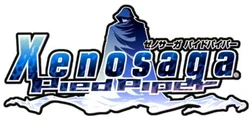
Xenosaga: Pied Piper logo.
- Main article: Xenosaga: Pied Piper
Released on phones in Japan, this Xenosaga side-story is set 100 years prior to the start of Episode I and explores the past of the cyborg character Ziggy when he was a human named Jan Sauer and working for the Galaxy Federation's counter-terrorism task force. The purpose of Pied Piper is to develop the back stories of some of the most important, yet rarely felt presences in the Xenosaga universe, including Ziggy, chaos, Wilhelm, Voyager and Dr. Dmitri Yuriev. The plot itself spans three chapters. It centers on Sauer and his team as they track a serial killer known only by the hacker alias "Voyager", who kills his victims using the U.M.N. network. The game was also Soraya Saga's final contribution to the Xenosaga project.
Xenosaga I & II
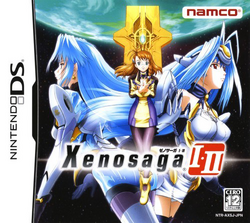
- Main article: Xenosaga I & II
Xenosaga I & II is a re-telling of the first two episodes of the game for the Nintendo DS handheld system. It is not an exact exact retelling of the previous two games; some minor changes were made. The Episode II portion of the game, originally told through Jr.'s perspective, focuses more on on Shion. The Episode II portion of the game is expanded and enhanced with new content (some of which was cut from the Episode II) from Xenosaga creator Tetsuya Takahashi.
The game plays out on the DS' top screen from the 3/4s perspective while the bottom touch screen is used to issue commands and navigate menus. The game's battle mechanics follow Episode I's style as opposed to Episode II.
The game's script is by Yuichiro Takeda, who worked on Xenosaga: The Animation. Hiroshi Takeuchi, of Cowboy Bebop fame, is responsible for character art. Music for the game is composed by Kousuke Yamashita, who scored the soundtrack for Xenosaga: The Animation. Other previous work includes the Hana Yori Dango and Mahou Sentai Majirenjaa Tabidate live-action television series and Nobunaga's Ambition video game series. Yamashita is the fourth composer to score a Xenosaga video game, following Yasunori Mitsuda, Yuki Kajiura and Shinji Hosoe.
Xenosaga I & II was released in Japan on March 30th, 2006.
Other projects
Xenosaga: The Animation
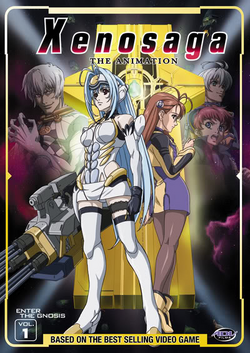
Vol 1. cover.
- Main article: Xenosaga: The Animation
A 12-episode anime based on Xenosaga Episode I, titled Xenosaga: The Animation, premiered in Japan on January 5, 2005.
The anime itself follows the story of Xenosaga closely, albeit removing several scenes and adding others. Some scenes were entirely re-written for the show's purposes. The pacing has the viewer running through the first ten to fifteen hours of gameplay of Episode I in the first five episodes. Given the nature of the anime, it works best as a supplement to Episode I; some points that the game explained poorly or didn't explain at all are brought to light in the anime.
Xenosaga: The Manga
- Main article: Xenosaga The Manga
In 2004, an official Japanese manga adaptation for Episode I was written by Atsushi Baba and published by Zero Sum Comics.


